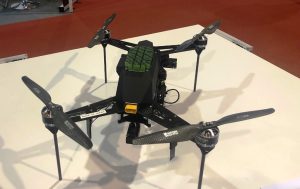
Unmanned Systems Asia: autonomous navigation from Japan
Autonomous Control Systems Laboratory (ACSL) was established in November 2013 leveraging the experience acquired by the Nonami Laboratory at Chiba University since 1998. ACSL has developed a proprietary autonomous control technology mostly aimed at industrial drones, however this can be of course of use also in UAS dedicated to security or military missions. The new ACSL autopilot flight controller uses advanced control technologies to realize full autonomous flight for drones of any form and size, and can adapt to various sensors. While exploiting when available GPS signals, ACSL new system integrated lasers and machine vision, on top of current inertial sensors enable autonomous flights in GPS-denied environment. A simultaneous Localisation And Mapping (SLAM) system was also developed allowing drones to operate autonomously in situations where even GPS-based positioning would not allow them to fly.
The ACSL-PF1 is an hexacopter weighing 6.2 kg with the two LiPo 6S 22.2 V 10,000 mAh batteries allowing 50 minutes fly without payload, maximum payload being 3 kg. The overall width of the UAS is 1,173 mm its height being 483 mm, the six 381 mm diameter XOAR rotors being driven by Shinano Kenshi brushless motors, a Toshiba Toshiba TPMD0001A electronic speed controller being installed. The PF-1 can reach a horizontal speed of 20 m/s and a vertical speed of 3 m/s, the UAS being capable to withstand a 10 m/s wind. Typical payloads are made of a gimbal with optronic sensors.

ACSL also exhibited a much lighter system, the Mini quadcopter, which weighs 2.4 kg including its battery, is also fitted with the company technologies allowing autonomous flight in GPS-denied environments.
Photos by Joseph Roukoz



